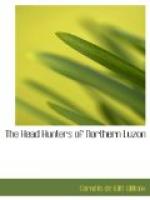We spent two days here, and over 10,000 people were collected; some of them apparently showed traces of Japanese blood. Gallman allowed me to make an inspection of his Constabulary, their quarters and hospital. The men were as fine and as well set-up as those we saw at Kiangan. Everything was in immaculate condition, and ready for service. From the circumstance of this inspection, I could not afterward pass near the cuartel that the guard was not turned out for “the General”—a fact amusing to me, but which I carefully concealed from the other members of the party. During these two days, nights too, the gansas never stopped, neither did the dancing. Mr. Worcester distributed thousands of paper slips, and, besides, much serious business was dispatched. Then we had sports and ceremonial formal dances, much like those we saw at Kiangan, but better done. There was the same slow advance with shields, the same sacrifice of a pig—only this one was not speared, but had his insides mixed with a stick. He proved obstinate, however, and refused to die, so a man sat down on the ground, put his thumbs on the victim’s throat, and choked him to death. Before that the usual lances had been laid across his body, and some bubud poured (judiciously, not extravagantly) on him as a libation. This was a head-dance, the taken head being simulated by a ball of fern-tree pith stuck on a spear fixed in the ground.
But these formal dances were not the only ones. Everybody danced, even Cootes and I again; but it was our last time. People kept on arriving from miles around, columns in single file, headed by men bearing bubud-jars on their heads. Every party, of course, brought its gansas, and had to give an exhibition of dancing on the parade. The arrival of the Mayoyao people on the 6th really made a picture, because we could see the trail for a long distance, occupied by men and women in single file, headed by Mr. Dorsey, of the Constabulary, on his pony. What with the budbud-bearers, the bright blue skirts of the women (color affected by these rancherias), and the cadence of the gansas to which they marched, it was a good sight, received with cheers. [31]
In general, but few parties were armed; and, as elsewhere, there were no old women. Some of the shyer people, coming from afar, had brought their spears, and, squatted on the slopes round about, apparently passed their time in silent contemplation of the great game going on below. Everybody seemed to be in a good humor. This was especially manifest in the great wrestling-match that took place on the afternoon of the 6th, when rancheria after rancheria sent up its best man to compete for the heads of the carabaos that had furnished meat for the multitude. The wrestling itself was excellent. The hold is taken with both hands on the gee-string in the small of the back; and, as all these men have strong and powerful legs,




